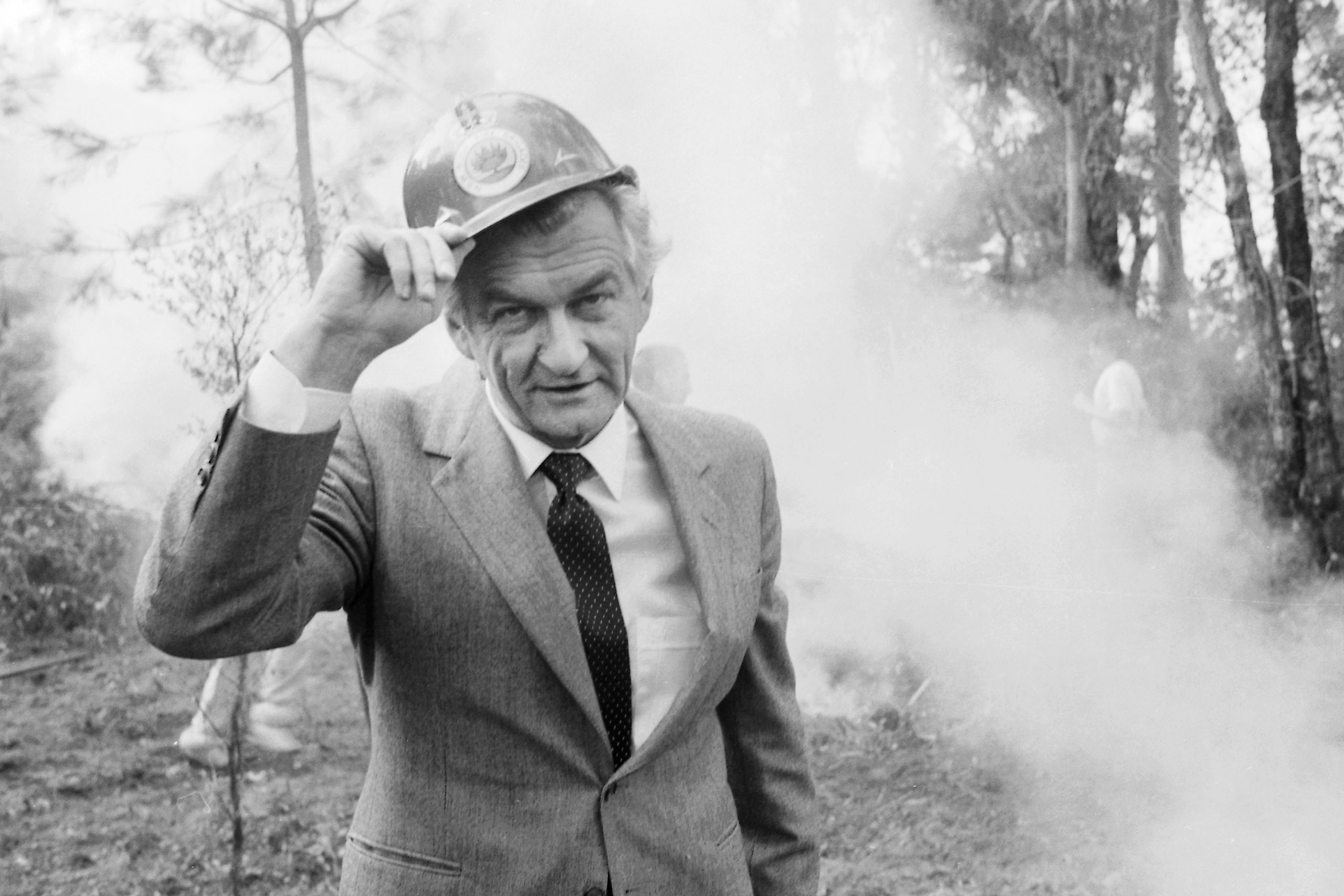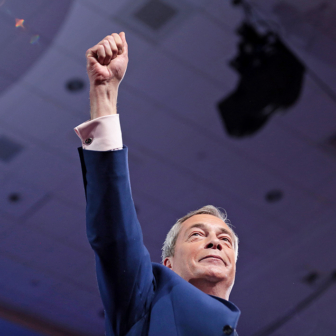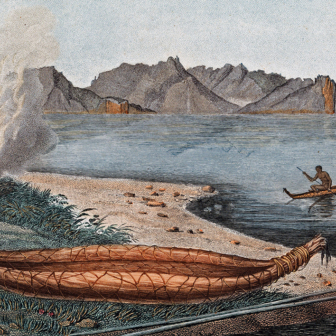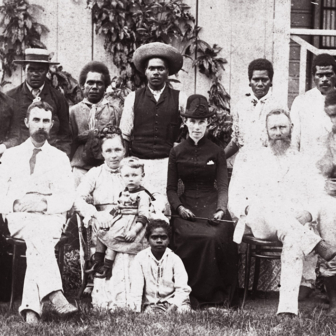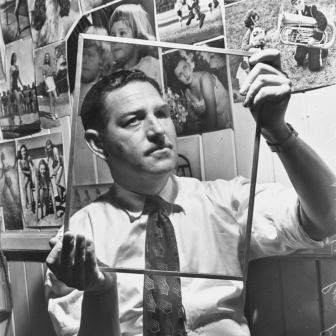Labour was the first and greatest of modern social movements, revolutionary in its effects even when it pursued mere reformism, a melodrama of heroes and villains like any grand theatre, and so pervasive in its influence that it came to be regarded as a kind of “estate” in modern industrial society. Especially so in Australia, where — in the nineteenth century — the worker was said to be king.
In Hawke PM: The Making of a Legend, David Day completes his two-volume biography of the country’s most famous and influential union leader, Bob Hawke, taking up the story from Hawke’s resignation as president of the Australian Council of Trade Unions, or ACTU, and entry into the federal parliament in 1980. Hawke would soon become one of the country’s longest-serving and most respected prime ministers.
Liam Byrne’s No Greater Power: A History of Union Action in Australia surveys a union movement that could produce such a figure. Hawke was famous for his hearty renditions of the old Industrial Workers of the World song, Solidarity Forever: Byrne’s title comes from its lyrics, which form the opening epigraph.
Alexis Vassiley, in Striking Ore: The Rise and Fall of Union Power in the Pilbara, belongs to a dissident labour history tradition which celebrates that song’s claim that “the union makes us strong.” But Vassiley sees the Prices and Incomes Accord championed by Hawke from 1983 as having disarmed the union movement: no longer does “the union’s inspiration” run “through the workers’ blood.”
Taken together, these books act as a reminder that any serious effort to understand the settler history of Australia needs to find a place for labour, the unions and the Labor Party. It might once have been unnecessary to have said as much, but not today, when only about 12.5 per cent of workers belong to a union. Mid-century, they represented about six in ten workers. Younger historians — indeed, younger people generally — tend to be more interested in other social movements, other causes: environmentalism, for instance, or the quest for the rights of women, sexual minorities or Indigenous people. But labour, as Byrne shows, has often been a presence in those battles, too.
For Liam Byrne believes that unions create “emotional communities,” and he conscientiously traces their widening circles. Those circles could encompass striking Aboriginal pastoral workers in the Pilbara by 1946 and at Wave Hill in the Northern Territory twenty years later: labour struggles that were tied up with quests for self-determination and land rights. Workers once treated by mainstream unionism as outsiders — including women and (non-British) migrant workers — were eventually brought inside, if not invariably on equal terms.
For Byrne, it is the union movement’s foundational battle for the humanity of the worker — the demand that labour be treated as something other than a mere commodity — that contains the seeds of these possibilities, even as the movement reflected and reinforced the wider racist and sexist prejudices of society in earlier times. It is the quest for dignity that gives union history its continuity despite the massive changes since building workers won the eight-hour day in the 1850s.
Byrne tells his story with passion and skill, conveying a real sense of how a longstanding mission can take radically different forms in a variety of new contexts. This is easily the best single-volume Australian general union history we have seen.
Because his concern is with the wider societal role of unions, the relationship between union leaders, officials and the rank and file is not a central theme. He recognises that “the union movement has had its fair share of bad-faith actors who have sought to use the movement for personal benefit rather than collective good.” But the union movement’s “humanising mission” is, for Byrne, the central thread. Union officials are, in the main, assumed to share in the emotional communities dedicated to advancing this goal even while they have, especially in a darker past, “perpetuated exclusions based on race, gender, and sexuality.”
While all that seems fair enough, union corruption deserves more attention than it receives here or elsewhere in mainstream labour history. The Painters and Dockers Union appears just once in No Power Greater, as donor of the chain Zelda D’Aprano used to attach herself to the Commonwealth Building in Melbourne in her famous 1969 equal pay protest. They don’t figure as an organisation that was integral to the nation’s problem of corruption in the 1970s, as uncovered by the Costigan royal commission. The links between organised crime and the Construction and General Division of the CFMEU are mentioned in a couple of paragraphs late in the book, but not the corrupt activities of some officials of the Builders Labourers Federation in the 1970s and 1980s.
By contrast, the relationship between union officials and the rank and file is central to Vassiley’s account of unionism on the Pilbara. The “second rush,” as David Lee has called it, is one of the more remarkable stories in modern Australian history. Iron-ore exports were effectively prohibited in Australia between 1938 and 1960 on the grounds that governments believed Australia’s reserves to be limited. When restrictions were lifted at the beginning of the 1960s, the industry developed rapidly in Western Australia, transforming not only that state but also, in time, the nation with it. The mining boom would be critical in the reorientation of Australia’s economic relationships, with Japan becoming the largest export market in 1967.
Workers have had less attention in accounts of the industry’s development than have Lang Hancock and other supposedly heroic pioneers or conservative political champions of the industry including David Brand and Charles Court. In a vivid account, Vassiley underlines the harshness of the conditions endured by workers in the industry, and their lack of sway over their working and living conditions, before the unions began to exercise their muscle. The companies controlled not only the workplace but housing and much else that happened in mining towns.
Union power on the Pilbara increased dramatically in the 1970s, but it was based strongly on local, democratic structures and the role of elected shop stewards and convenors. The Pilbara was far from where most paid officials were to be found, and there were frequent tensions between the central authorities within the unions (and the Trades and Labor Council in Perth) and local unionists.
Vassiley refers to these paid officials as “the trade union bureaucracy,” and the usage is not intended to flatter. In Striking Ore officials routinely sell out the workers and local activists. The physical and especially social distance of the union bureaucrats from ordinary workers means their tendency is towards compromise with management. Nonetheless, in line with a national upsurge of shopfloor militancy during the 1970s, the Pilbara unions used strike action to increase miners’ wages and improve their quality of life. Even in the face of anti-union legislation from Charles Court’s conservative government, they asserted their power and turned company towns into union towns, as Vassiley neatly puts it.
Then it all went wrong. Vassiley sees the Prices and Incomes Accord as the main culprit because it elevated the influence of that “union bureaucracy” and blunted union power by imposing wage restraint in return for a social wage. This reading is in line with a Marxist argument developed at greater length by Elizabeth Humphries in her How Labour Built Neoliberalism: Australia’s Accord, the Labour Movement and the Neoliberal Project (2019), which makes the case that the Accord facilitated neoliberalism by bringing the unions, through their leaders, into a corporatist relationship with government and business. Byrne, for his part, is more equivocal in No Greater Power. The Accord brought benefits, but not all workers shared in the subsequent economic growth, delegate structures were weakened, and when enterprise bargaining came along during a recession, unions were vulnerable.
Vassiley’s study of the Pilbara stands as a revealing regional and industry case study of how these processes played out. Over the course of the 1980s and 1990s, beginning with what he regards as the defeat of the unions in the 1986–87 Robe River dispute, union power on the Pilbara was wrecked and the unions themselves virtually disappeared. By the beginning of this century, workers had been induced on to individual contracts with large wage increases.
Vassiley seems to believe that the militant tactics used in the 1970s — at one point workers demanded, and apparently received, the accrual of annual leave while on strike — would have been capable of working in the 1980s and 1990s if not for the Accord and the union “bureaucrats” it empowered. I’m less convinced. By the mid-1980s, employers were experimenting with common law remedies against unions. In 1992 Hamersley Iron sought damages of $49 million from the unions. Vassiley seems to assume that continuing militancy would have made these kinds of threats go away.
It is also unclear what capacity Pilbara working-class communities had to endure long strikes by the 1980s. Personal credit expanded dramatically during that decade, creating its own vulnerabilities; and neoliberalism — or economic rationalism, as it was then called — was everywhere eroding older forms of collectivism in a rapidly expanding consumer economy. Even allowing for union financial support, strikes of one, two or three months imposed serious burdens on workers and their families. When workers took large pay increases and individual contracts in the 1990s, and many reverted to fly in, fly out, or FIFO, arrangements, they were responding not only to a new industrial relations regime imposed by conservative governments but also to a new individualism.
As Vassiley argues convincingly, the results have been devastating to health and wellbeing. But it might be wishful thinking to imagine that continuing militancy could have done much to counter these developments. In the end, explaining their inability to defeat the mining companies, Vassiley says that unionists “lacked the political sophistication necessary.” Few Pilbara unionists were members of political parties, he explains. One might add that few workers of any kind, anywhere in Australia, belonged to political parties, and fewer still to the kind of socialist organisation Vassiley clearly believes was needed.
All of this comes close to a Marxist concept of false consciousness. But the problem here might be that Vassiley treats an unusual period in labour history, the militancy of the 1970s, as if it were the most authentic expression of movement ideology and practice. He worries over the Accord’s elevation of “moderate demands, reliance on the legal system and employers, infrequent strikes, an ideology of partnership and the use of consultative committees.” But wasn’t this the essence of the Australian union movement under the longstanding system of compulsory arbitration?
Militant unionism has only ever been one strand in labour tradition, as Byrne’s survey shows well. The period between the Clarrie O’Shea strike of 1969, which largely rendered the penal provisions of the arbitration system inoperative, and the signing of the Accord in 1983 looks more like a response to the particular conditions of the era — political, industrial and economic — than a blueprint for the future of fighting unionism.
In the first volume of his Hawke biography, Young Hawke, David Day showed how the future prime minister crafted national celebrity on the back of his leadership of the union movement during that very period of turmoil, the 1970s. In Hawke PM, Day takes up the story of Hawke as parliamentarian, shadow minister and prime minister — and finally and briefly, as an ambiguous elder statesman. This is as close as we have to a debunking biography of Hawke and it could not have been written while the famously litigious man was still alive.
That is not to suggest it is unbalanced or unfair. But nor does it flatter Hawke. And it is sometimes shocking. Day deals with the allegation that union leader and Hawke ally, Bill Landeryou, raped Hawke’s daughter, Rosslyn. And he accepts that Hawke pressured Rosslyn into not taking the matter to the police because he needed Landeryou’s support and could not have a controversy while he was seeking the party leadership.
Following revelations in Troy Bramston’s Hawke biography of 2022, Day also refers to continuing infidelities and sexual conquests while noting that the prime ministership, and life in the Lodge, did seem for a time to bring greater happiness to his marriage to Hazel Hawke. But Hawke would also resume the relationship with former lover, biographer and future wife, Blanche D’Alpuget, while prime minister.
The more significant theme of Day’s biography is corruption, one he flagged in the earlier volume. That Hawke had close relations with “shady characters” is clear enough. Hawke accepted benefits from rich friends such as transport magnate Peter Abeles, who had links with the mob in the United States. Today, with the more developed integrity system in place, it is hard to believe Hawke would not have been exposed. By the looser standards of his own time, he seems to have been able to get away with much.
“Over the years,” Day observes, “he’d frequently put himself in situations where he’d been paid large sums of money and where favours might be demanded of him in return.” Abeles and Gold Coast businessman Eddie Kornhauser were among those with whom Hawke established these relations. It is startling to be reminded that Hawke appointed Abeles to the board of the Reserve Bank.
What makes all this genuinely interesting is that he was prime minister at a time when the modern integrity system was beginning to take shape following the Costigan royal commission. Corruption was a live issue in the late 1970s and early 1980s, and it exploded into federal politics in 1984 when opposition leader Andrew Peacock described Hawke in parliament as “a little crook… who associates with criminals and takes his orders from those who direct those criminals.” Peacock largely fluffed this attack by failing to provide evidence of Hawke’s corruption. (Forced to withdraw the comment, he described Hawke as “a big crook in a little frame,” which also had to be withdrawn.) But Day believes there was something in Peacock’s accusation and that “[a]s a habitué of racetracks and casinos and a patron of SP bookmakers and prostitutes, Hawke knew that he was vulnerable to a potential exposé by a courageous journalist or a speech by a politician taking advantage of parliamentary privilege.” Still, if he was so vulnerable, it remains puzzling that the Coalition had so little success in pinning anything much on him.
It is at this point that Day’s argument about Hawke and corruption enters murky territory. Is there any evidence that Hawke did, in fact, fear exposure of the kind suggested here? None is really given and Day later goes on to explain that “Hawke’s narcissism encouraged him to think of himself as relatively invulnerable to attack by his detractors.” That seems like having one’s cake while eating it too.
In the context of media exposés of corruption in high places in 1984, Hawke called an early federal election that Day believes might have been motivated by his fear that recordings of his conversations with Abeles might be exposed in the media, as had the conversations of others (and Abeles did feature in some tapes). Again, is there evidence that this was a consideration in Hawke going early? Again, none is provided.
Day also suggests that the early election of 1987 might have been related to Hawke’s fear that he could come up in the Fitzgerald inquiry hearings in Queensland, given his connections to Kornhauser, who had sought to influence corrupt Queensland minister Russ Hinze by giving him a $250,000 “loan.” Again, the suggestion of a fear of exposure as a reason for an early election seems speculative. There were plenty of other good reasons, including Joh Bjelke-Petersen’s crazed grab for a career in Canberra, to go to an election when Hawke did.
My sense is that this is a case of joining dots and pushing arguments further than they needed to go. Nonetheless, that Hawke traded favours for financial and other benefits with Abeles in particular is hardly in doubt. Hawke’s over-the-top response to the pilots’ strike in 1989 was surely, as Day indicates, as much about his relationship with Abeles, half-owner of Ansett, as it was about the threat the pilots’ salary claims posed to the Accord arrangements.
In general, Day makes a strong case that any assessment of Hawke needs to grapple seriously with the question of corruption. The connection between Hawke and Abeles remains a piece of the puzzle of Hawke’s career, and his government, that is not yet quite in place. It was clearly much more than a matter of mutual convenience, although there was plenty of that. Strong bonds appear to have been in play — not only financial and political, but also emotional — that need further untangling.
The businessman was about five years older than Hawke; there are hints of a kind of protective older brother sort of relationship, but also of much else that seems to lie a little beyond our grasp at present. We would all benefit if someone were to write a good biography of Abeles.
Given these revelations, is Hawke to be seen as the kind of “bad-faith” actor Byrne refers to, one who pursued private gain rather than the collective good through the union movement?
In the end, I think that would a harsh judgement, and Byrne would clearly agree with me. He shows that Hawke was a committed, and gifted, advocate for the ACTU. Interestingly, in his discussion of Hawke’s contributions of the 1950s he reveals a man continuing in the tradition of Henry Bournes Higgins’s notion of wage justice, updated by Hawke to argue that workers should receive the benefits of increasing productivity in the relatively good economic times of the 1950s and 1960s. Hawke was very much a child of the arbitration system: it was before the commission that he first made his name. All of that was rather “old Australia” and “old labour.”
But Hawke’s achievement lay in his adaptability, his ability to rethink the philosophy, approach and role of unions in the country that emerged with the end of the long postwar boom. Perhaps, as a biographer, Day gives Hawke too little credit for that ability and achievement. Vassiley — in arguing that the social wage offered by the Accord was “an illusion” — is surely also being stingy. Medicare and superannuation might not always be all they are cracked up to be, but both were products of the social wage side of the Accord, and they have offered many working people affordable healthcare and a dignified retirement. There is a longstanding tradition on the far left of dismissing such benefits as palliatives, but they have advanced the mission that Byrne sees as the union movement’s: “the assertion and recognition” of workers’ “fundamental humanity.”
The challenge for the union movement is how it can continue that mission in the context of increasingly aggressive efforts to reduce large numbers of workers to mere robots — or, where possible, to replace them altogether with robots. Militancy and grassroots organisation will need to play a role here, as Vassiley would want, but it probably won’t yield the kinds of mass strikes seen in the Pilbara in the heyday of unionism — which he also wants. It will more likely involve the kinds of painstaking worker-by-worker organisation that Byrne describes being led by unions — or rather, by those pesky, interfering “bureaucrats” — among outworkers and gig workers, many of them migrants.
This all bears more than a passing resemblance to the shed-by-shed organisation of the early shearers’ unions. Success in that endeavour will almost certainly require legislative protection to ensure that modern algorithms don’t function like the employer blacklists of those times to exclude from work those who join unions and demand their rights. •
Hawke PM: The Making of a Legend
By David Day | HarperCollins Publishers | $49.99 | 374 pages
No Power Greater: A History of Union Action in Australia
By Liam Byrne | Melbourne University Press | $34.99 | 304 pages
Striking Ore: The Rise and Fall of Union Power in the Pilbara
By Alexis Vassiley | Monash University Publishing | $39.99 | 278 pages
